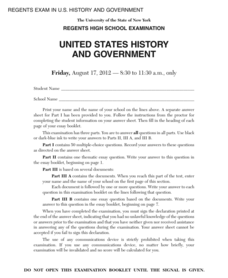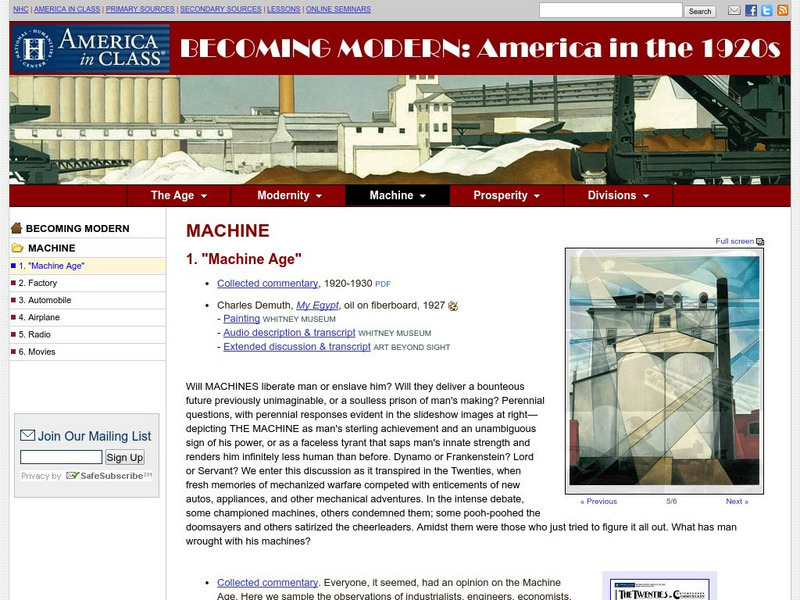Core Knowledge Foundation
Volume 2 - A History of the United States: Modern Times—Late 1800s to the 2000s
The second volume of the Core Knowledge History of the United States ebook begins by asking young scholars to consider the impact immigration, industrialization, and urbanization had on the United States in the late 1800s. The text ends...
Penguin Books
A Teacher's Guide to the Signet Classics Edition of H.G. Wells's The Time Machine
Imagine being able to travel back and forth in time! H.G. Wells uses that scenario in his novel The Time Machine to comment on what he saw as the flaws in Victorian society and the industrial age. This teacher's guide is one of...
Core Knowledge Foundation
Unit 4: The Time Machine by H. G. Wells Teacher Guide
Lead your readers into the fourth dimension as time travelers with a Core Knowledge Language Arts (CKLA) Teacher Guide of H. G. Wells's The Time Machine. The 144-page guide includes a unit calendar, introduction, nine lessons, teacher...
Simon & Schuster
Classroom Activities for The Jungle by Upton Sinclair
A 15-page packet includes detailed plans for three activities related to Upton Sinclair's The Jungle. To gather background information, class members research topics and create a newspaper page reporting their findings. After finishing...
Academy of American Poets
Teach This Poem: “As I Walk These Broad Majestic Days” by Walt Whitman
Walt Whitman's poem "As I Walk These Broad Majestic Days" offers scholars an opportunity to practice their noticing skills. They first examine a postcard of the Newport News Shipyard listing things they notice about the image and how...
National Woman's History Museum
The Triangle Shirtwaist Fire
On March 25, 1911, 146 garment workers died in the Triangle Shirtwaist Factory fire. Class members use primary source documents to research the tragedy and how it lead to the creation of labor unions and new labor laws. As an exit...
Alabama Department of Archives and History
Working in Birmingham's Iron Industry
What did railroads, iron, and industry contributed to Birmingham's successful growth? The lesson explains how the iron industry worked. It also describes how the location of Birmingham and its proximity to railroads. played a key role in...
New York State Education Department
US History and Government Examination: August 2012
Just how far can the American government go during war time? With primary source documents, learners consider the effects on restrictions of freedom of speech, the detention of American citizens of Japanese descent, and the Patriot Act...
Syracuse University
American Industrial Revolution
While the Industrial Revolution may have fueled America's rise to the top of world markets, the child laborers often faced dangerous conditions. Using primary source images and other information, scholars consider what these children...
Syracuse University
Erie Canal
While canals are not the way to travel today, in the first half of the nineteenth century, they were sometimes the best way to move goods and people. Scholars examine primary sources, including maps and pictures, to investigate the role...
Benjamin Franklin Tercentenary
Simple Machines, Ben Franklin and the Technology of the 1700s
Benjamin Franklin was an inventor, and he was fascinated by the mechanics of machinery. Using a fun exploration, pupils examine simple machines from the pre-Industrial era. Then, they must identify and build their own using common objects.
College Board
2017 AP® World History Free-Response Questions
Religion and politics have a complicated history. How were they intertwined with wealth in Europe and Asia in the Middle Ages? Learners explore the question using a prompt based on primary sources. Other activities allow individuals to...
National Endowment for the Humanities
Life Before the Civil War
American life before the Civil War was very different from American life today. To show this difference in a full spectrum, learners compare two communities that illustrate the differences between Northern and Southern life. Throughout...
EngageNY
Grade 9 ELA Module 4, Unit 1, Lesson 21
Class members read the chapter, "Serfs and Sweetness" from Sugar Changed the World, and identify the central idea that the development of beet sugar and modern farming technology changed the reliance on the plantation system and made...
Roy Rosenzweig Center for History and New Media
Labor Unions in an Industrializing U.S.
Have class members eager to enter the workforce? They'll be glad to learn that things aren't how they used to be. Have your young historians examine then discuss four primary source images related to the negative effects of...
Core Knowledge Foundation
Isn’t It Exciting? (The American Industrial Revolution and Urbanization)
America was built on the ingenuity, work ethic, and foresight of our ancestors. Sixth graders learn about the complex Gilded Age in American history, including the prominent inventors and captains of industry, and how they all connect...
Latin America Network Information Center
Urbanization
Brazil's population has been changing dramatically in the last century. Study the causes of Brazilian urbanization, including industrialization and and migration, and the implications for the country of the populations'...
Pulitzer Center
China's Rising Labor Movement
Young historians will explore the complex causes and effects of industrialization in China by perusing the numerous articles included in this webpage. Throughout the resource, there are many writing and discussion prompts to help direct...
National Humanities Center
National Humanities Center: Toolbox Library: Gilded and Gritty: People: Assimilation and the Crucible of the City
Collection of ten primary resources on the culture, economy and politics of the Gilded Age between 1870-1913, with reading guide for discussion, timeline and links to supplemental material.
Library of Congress
Loc: The Industrial Revolution in the United States (Teacher's Guide) [Pdf]
The Industrial Revolution was a complex set of economic, technological, and social changes that occurred over a substantial period of time. This teacher's guide gives background information, and suggestions for stimulating student...
National Humanities Center
National Humanities Center: America in Class: America in the 1920s: "Machine Age"
The National Humanities Center presents collections of primary resources compatible with the Common Core State Standards - historical documents, literary texts, and works of art - thematically organized with notes and discussion...
Internet History Sourcebooks Project
Fordham University: Modern History Sourcebook: Women Miners in English Coal Pits
Detailed essay, written in 1842, on women and girl miners' working conditions in Great Britain. Includes the personal accounts of two women miners.
Internet History Sourcebooks Project
Fordham University: Modern History Sourcebook: Richard Guest: The Steam Loom, 1823
The Fordham University provides information about the application of steam power, which accelerated the centralization of textile production in factories.
Internet History Sourcebooks Project
Fordham University: Modern History Sourcebook: The Rise of Our East African Empire, 1893
This Fordham University site offers a primary source from a British Captain stating the argument for British imperialism of East Africa.





















![Loc: The Industrial Revolution in the United States (Teacher's Guide) [Pdf] Unit Plan Loc: The Industrial Revolution in the United States (Teacher's Guide) [Pdf] Unit Plan](http://content.lessonplanet.com/resources/thumbnails/409989/large/bwluav9tywdpy2symdiwmduymc0xndu3ns0xexltmxrtlmpwzw.jpg?1589982864)



